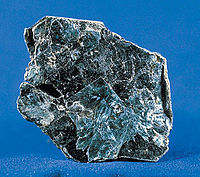
Photo from wikipedia
The partitioning of carbon between the core and mantle during the formation of terrestrial planets may have controlled the distribution of carbon in terrestrial planets. However, the abundance of carbon… Click to show full abstract
The partitioning of carbon between the core and mantle during the formation of terrestrial planets may have controlled the distribution of carbon in terrestrial planets. However, the abundance of carbon in the Earth's mantle is higher than a prediction based on previous metal‐silicate partitioning experiments of carbon at carbon‐saturated conditions by more than an order of magnitude. Here, we report new metal‐silicate partitioning experiments of carbon at carbon contents of 0.25–0.5 wt%. We show that the metal‐silicate partition coefficient of carbon ( DCmet/sil ) strongly correlates with nonbridging oxygen per tetrahedral cations (nbo/t) of silicate melts at fO2 conditions where C‐H species are stable. Moreover, the results suggest that DCmet/sil at carbon‐undersaturated conditions may be lower than that at carbon‐saturated condition. Thus, DCmet/sil at low carbon concentrations is essentially important to investigate the distribution of carbon in the Earth during the core formation.
Journal Title: Geophysical Research Letters
Year Published: 2019
Link to full text (if available)
Share on Social Media: Sign Up to like & get
recommendations!